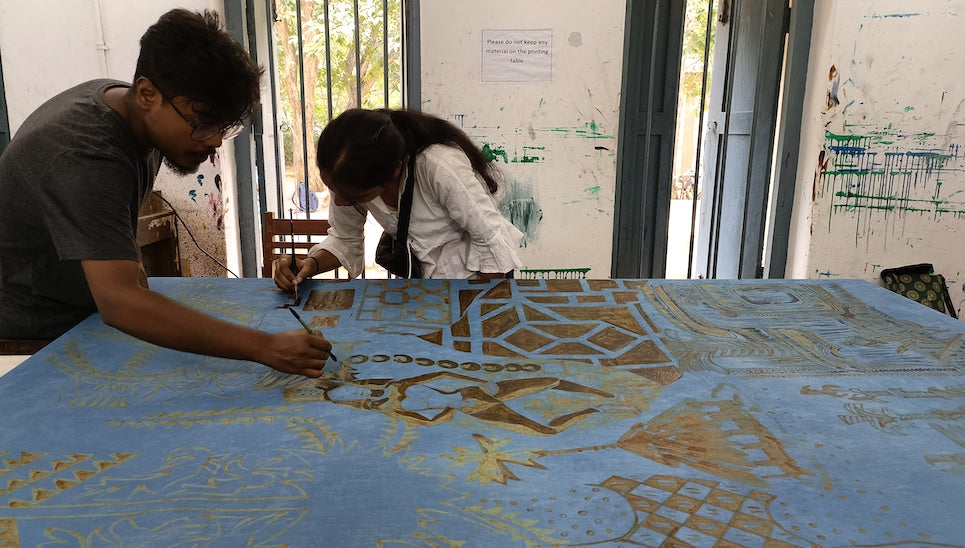
Batik in Santiniketan, West Bengal
Batik originates from the Javanese word Ambatik (Amba means to write, and Titik means dots). An ancient wax-resist dyeing tradition with highly sophisticated artistic skills involves creating patterns and designs on fabric using molten wax and immersion in sequential dye baths. Batik was developed in Indonesia and on the island of Java. Although the place of origin of batik is still debated, evidence of some wax-resist dyed fabric has been widely found over the last two millennia in Indonesia, Japan, Egypt, Malaysia, and India.
Pratima Tagore, the daughter-in-law of poet Rabindranath Tagore, first learnt the batik technique in Paris from a French artist, Mon Mieux, who brought a set of instruments with her to Santiniketan. The methods were known through translations from Rouffaer and Joynboll’s book. In 1922, Bichitra, a handicraft sector, was established by Pratima Devi and French artist Andre Karples to promote indigenous craft practices in India. Andree Karpeles wrote about the practical aim of Bichitra: “To establish permanent co-operation between the artisans and craftsmen. . . . To keep the love of beauty in the simplest objects of daily use which were so characteristic of Indian life and provided the artists and craftsmen with such a wide field of creative expression.” This organisation was primarily concerned with reviving and promoting local arts and crafts. Bichitra did not last long, but its spirit continued to inspire.

In 1927, Tagore went to Java and was deeply impressed by the batik designs he saw there. Surendranath Kar, the well-known artist and architect of Santiniketan, who accompanied Tagore on this trip, learned batik’s technique there. Tagore received a piece of batik from his host, the Rajah of Java and became aware of the exclusiveness of the Javanese batik. In a letter written to his daughter-in-law, Pratima Devi, he mentioned the batik fabrics in the costumes of Javanese dance, dance dramas, stage decorations, and home decor. So, to introduce the tradition of this wax-resist dye textile to India, he brought a few pieces of fabric from Java to Santiniketan, West Bengal.
Pratima Tagore, the daughter-in-law of poet Rabindranath Tagore, first learnt the batik technique in Paris from a French artist, Mon Mieux, who brought a set of instruments with her to Santiniketan. The methods were known through translations from Rouffaer and Joynboll’s book. In 1922, Bichitra, a handicraft sector, was established by Pratima Devi and French artist Andre Karples to promote indigenous craft practices in India. Andree Karpeles wrote about the practical aim of Bichitra: “To establish permanent co-operation between the artisans and craftsmen. . . . To keep the love of beauty in the simplest objects of daily use which were so characteristic of Indian life and provided the artists and craftsmen with such a wide field of creative expression.” This organisation was primarily concerned with reviving and promoting local arts and crafts. Bichitra did not last long, but its spirit continued to inspire.

In 1927, Tagore went to Java and was deeply impressed by the batik designs he saw there. Surendranath Kar, the well-known artist and architect of Santiniketan, who accompanied Tagore on this trip, learned batik’s technique there. Tagore received a piece of batik from his host, the Rajah of Java and became aware of the exclusiveness of the Javanese batik. In a letter written to his daughter-in-law, Pratima Devi, he mentioned the batik fabrics in the costumes of Javanese dance, dance dramas, stage decorations, and home decor. So, to introduce the tradition of this wax-resist dye textile to India, he brought a few pieces of fabric from Java to Santiniketan, West Bengal.
Want to read more of this article?
We are proud to be a subscriber-funded publication with members in 185 countries. We know our readership is passionate about textiles, so we invite you to help us preserve and promote the stories, memories, and histories that fabric holds. Your support allows us to publish our magazine, and also ‘what's on’ information, and subscription interviews, reviews, and long-read articles in our online blog.
ALREADY A SUBSCRIBER? CLICK HERE TO ACCESS CONTENT

